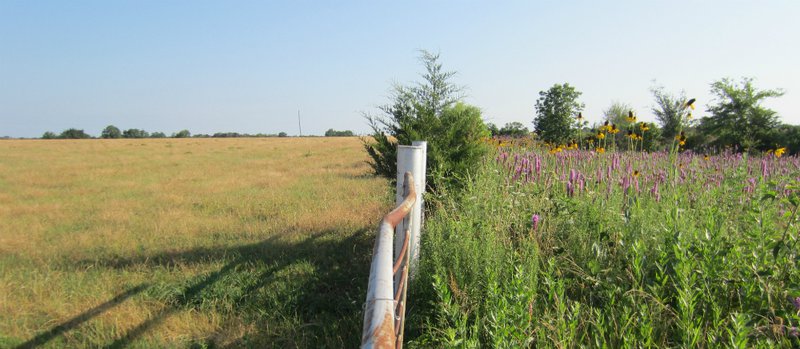Native Bee Needs — Adapt Management
Management practices, such as grazing, haying, and prescribed burning can limit woody plant encroachment, suppress non-native plants, and enhance native herbaceous plant diversity. However, these practices should be implemented with the needs of native bees and other insect flower-visitors in mind as these practices have the potential to reduce or even completely eliminate floral resources, host plants, and nest sites. Certain management activities, if performed without care, can even harm pollinators and extirpate them from a site.
When applying any management practice to a property it is critical to avoid treating an entire area in one season. A site that is burned, grazed, or hayed in its entirety in the dormant season will virtually eliminate those native bees that are overwintering in dry stalks, stems, and twigs. Some pollinators, such as some species of butterflies, beetles, and flies overwinter in leaf litter and may be severely impacted by prescribed burns during the winter. Implementing these same practices to an entire site during the growing season will remove nearly all flowers (nectar and pollen resources), potential nest sites, and host plants of butterflies and moths. If the surrounding area does not support populations of these bees and butterflies, disrupting the entire site at one time could cause you to lose pollinator species diversity.

As a general rule, only treat up to 30% of a site at a time. For example: if you have a 12-acre, flower-rich hay meadow, only cut four acres in a single year and rotate through the remaining acreage over the following years. Untreated areas of the property will provide much needed food and nest sites and also serve as critical refugia for species to recolonize the managed portion as it recovers the following year.
The prescriptions below are general guidelines to maintain areas with existing native insect pollinator habitat on your property. If you are actively restoring a property to a more natural state, you may find the need to conduct management outside of the time periods suggested below.
- Prescribed burns should be conducted from fall into early spring. Avoid burns during the growing season. Allow sufficient time for recovery between burns (burn cycle will vary by ecoregion) for thatch to accumulate and enable insect populations in burned sections to recover.
- Cattle grazing should be designed to protect and enhance areas containing nectar and pollen resources. Grazing intensity may be low to high depending upon the goals of your management plan. Low intensity grazing tends to promote selective consumption of grasses and the more palatable forbs, while high intensity grazing leads to uniform consumption of plant matter across the landscape. Low intensity, short duration grazing from fall into early spring may have the least impacts on native bee resources. High intensity, short duration grazing may be needed in restoration efforts to increase seed germination or control non-native grasses. Avoid grazing with goats or sheep as these feed more heavily on important nectar and pollen-bearing wildflowers.
- Haying should be restricted to fall through early spring to maximize availability of flowering plants for native bees. Avoid haying too low, as bumble bees often nest in ground-level accumulations of thatch. Instead, maintain a minimum cutting height of six to eight inches. If haying must be conducted during the growing season, leave blocks or strips uncut to retain some stands of flowers and nest sites. Avoid the application of chemical fertilizers, as these can increase the growth of non-native grasses and weeds to the detriment of annual and perennial wildflowers.
- Tilling or deep disking in areas that host aggregations of ground-nesting bees should be avoided. Tilling and disking also may promote the invasion or germination of non-native plants.
Try to vary the techniques applied to each site as much as possible. Reliance upon a single practice year after year can lead to a shift to a more homogeneous plant community. Applying a range of practices will result in a more diverse and healthy landscape.
A number of steps can be taken to further secure nesting habitat resources on your property.
- Allow dead trees to stand (so long as they do not pose a risk to property or people) and protect shrubs and herbaceous plants with pithy or hollow stems (e.g. cane fruits, sumac, elderberry), as these provide nesting habitat for tunnel nesting native bees.
- Retain dead or dying branches whenever it is safe and practical. Wood-boring beetle larvae often fill dead trees and branches with narrow tunnels into which dead wood-nesting bees will establish nests. Additionally, bumble bees may choose to nest in wood piles.
- Retain rotting logs where some bee species may burrow tunnels in which to nest.
- Protect sloped or well-drained ground sites where plants are sparse and direct access to soil is available. These are the areas where ground-nesting bees may dig nests. Turning the soil destroys all ground nests that are present at that depth and hinders the emergence of bees that are nesting deeper in the ground.
- Protect grassy thickets, or other areas of dense, low cover from mowing or other disturbance. These are the sites where bumble bees might find the nest cavities they need, as well as annual and perennial wildflowers that can provide important food resources.